All about red-leaved plums
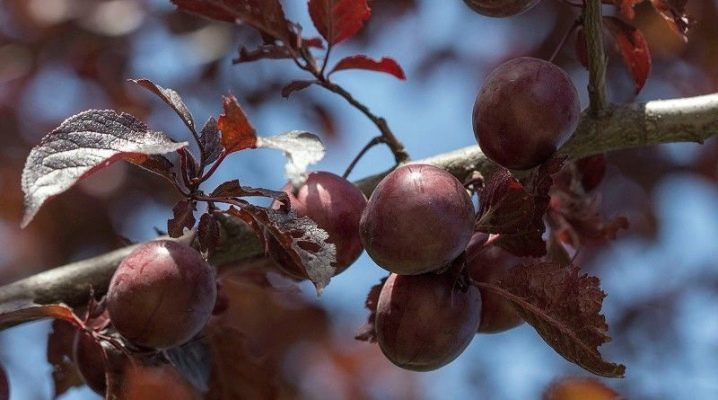
Red-leaved plum is a popular garden plant with a purple crown. Summer residents are familiar with many of its varieties: "Hessey", "Lama" and others, some of them bear fruit, performing not only decorative functions in the garden. A description of how the spreading decorative plum and other types of red-leaved trees grow on the site will help to better understand all its diversity.
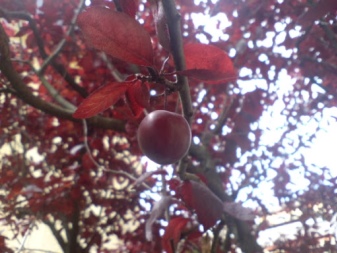
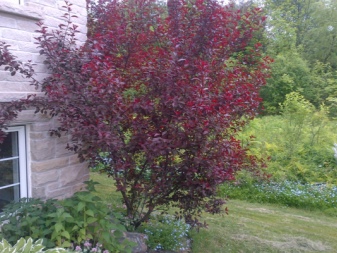
general description
Red-leaved plum belongs to the category of fruit plants of the Pink family, the Almond subfamily. Its leaves are painted in a red-violet, purple hue, which makes them a bright accent against the background of other plants in the garden. With standard cultivation on 1 trunk, you can get a rather tall tree, which becomes a tapeworm in plantings. While maintaining a multiplicity of trunks, the plant looks more like a shrub. It is used for background plantings or the formation of spectacular hedges.
A distinctive feature of red-leaved plums can be called pliability to crown formation. It easily accepts the given parameters, blending harmoniously into the overall concept of landscape design.
But it is important to know that with massive pruning, the tree will interrupt the fruiting cycle. It is not always possible to renew it. Moreover, the life span of a plant is rarely less than 50 years.

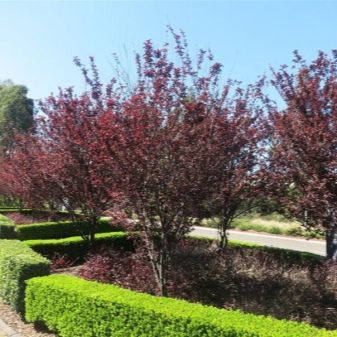
Among the obvious advantages of the red-leaved plum, a high level of immune protection can also be noted. She is not susceptible to diseases typical of her species, but can suffer from aphid attacks. The trunk is grown with the standard type of formation up to 6 m in height, the bush forms are much lower. Plants bloom quite amicably in April, but they have to harvest only in autumn, before the onset of frost. Moreover, its taste properties are difficult to assess positively - the fruits are very small, rather dry.

Overview of species and varieties
There are several types of plums with red, burgundy or purple leaves. Almost all of these plants are zoned for the Moscow region. Sometimes they are called red-leaved cherry plum, but in general it is the same decorative form of the well-known fruit tree. The main classification looks like this.
Russian plum
A whole line of hybrids is known under this name, obtained by crossing the southern cherry plum and the Chinese or Ussurian plum. The most popular subspecies in this category deserve special attention.
- "Scarlet Sails". A variety of Russian plum, formed in the form of a tree up to 4-5 m high, with large scarlet leaves and pink flowers. The variety is fruiting, the harvest is carried out from the 2nd decade of August. The shade of the plum is dark crimson, each fruit weighs about 25 g. For fruiting, the tree needs pollinators nearby - you can plant cherry plum or other related species to get a harvest every year.
- "Lama". Very compact decorative variety, fruiting, with a flat-rounded crown. Leaves throughout the season have a dark red tone, pink flowers, large plums, up to 40 g. "Lama" grows up to 2 meters, suitable for growing in northern climatic zones and in the middle lane. The resistance of this plum to diseases and pests is above average, but it is self-fertile, pollinating plants should be planted nearby.
- "Early". One of the largest Russian plums, grown in the form of a tree, reaches 7 m in height. The crown is rounded, covered with red leaves with a brown back. The hybrid has good immunity, frost-resistant.The yield of the tree is high, but it needs pollinators nearby - a Chinese plum or cherry plum is suitable.
- "Nigra". The hybrid forms compact trees with an oval crown and bright purple leaves. The flowers are pink, appear before bud break, fruiting occurs in August. This type of Russian plum winters well without shelter in the middle lane; for pollination of a self-fertile tree, you can use "Hungerka".


Not less popular among gardeners are spreading plums, also belonging to the category of red-leaved ones. Here you can pay attention to the Cistena variety. It forms as a shrub with a very decorative pyramidal crown. There are fruits, but they are hardly edible. In addition, due to its low frost resistance, Cistena is difficult to grow in regions with a cold climate.
"Pissardi" is another kind of spreading plum. The red-leaved tree forms an extensive, branched crown. Special attention is drawn to the unusual leaves - purple, of the original form, they become a real decoration of the garden from spring to autumn. The fruits have no particular nutritional value.

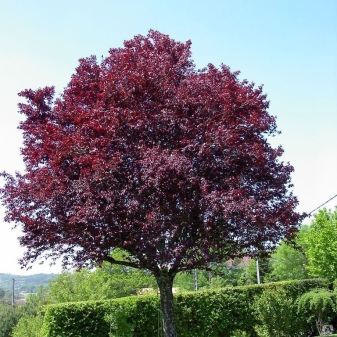
For lovers of dwarf and slow growing varieties, the spread-out "Hessey" plum is suitable. Her leaves are green in spring, then gradually change their shade to purple. This creates a creamy edging along the hem. The taste of this plum is quite good, the fruits can be eaten fresh or used for canning.
If you want to decorate the garden, you can choose a purple-leaved plum for this purpose. This ornamental shrub is focused on use in the field of landscape design. The height of his shoots does not exceed 1.5 m, the leaves are dark scarlet at first, then gradually become claret-brown. The shrub blooms with very beautiful pink buds in spring. The purple-leaved plum grows well in tubs and other containers, for the winter it is removed to a shelter.

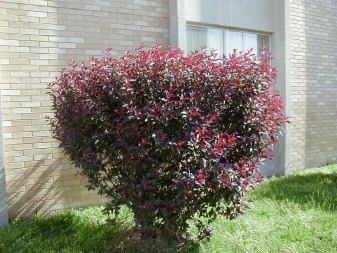
The red-leaved table variety "Hollywood" can be called a real champion in popularity. This plum forms neat trees, stretching up to 4-5 meters. The crown is rare, but broadly spreading, shoots and leaves are colored dark red. By mid-August, purple-crimson fruits appear on the branches.
To pollinate a self-fertile tree, it is worth planting Mirnaya or Renklod plums nearby.
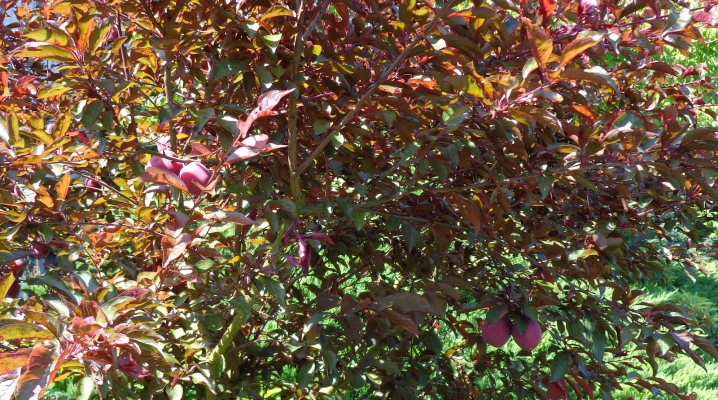
The nuances of growing
Red-leaved plums are usually divided into completely decorative and fruiting varieties. That is why it is difficult for them to formulate general recommendations for growing. But some points can still be highlighted.
- For planting, it is best to choose a soil that is relatively dry, with neutral acidity. Waterlogged soil leads to the death of plants. At least 1.5 m from the roots must remain to the layer where the groundwater lies.
- The seedling pit is prepared by applying fertilizers. A mixture of organic matter is suitable - humus, peat with superphosphate. This is enough to provide the plum with nutrition for the first 3 years of life.
- Planting trees with an open root system is carried out in the fall in the southern regions, and in the rest only in the spring. You can save the plant by digging it in at an angle for storage. In the presence of a closed root system, the time for planting is chosen from late spring to mid-summer.
- Red-leaved trees begin to bear fruit at the 5th year of life. From this point on, they need regular feeding. In the spring, nitrogen organic fertilizers are applied, in the summer potash and cow dung solution. In the fall, it will be useful to loosen the soil well, and then mix it with humus.
- Frequent watering is not needed. But with prolonged dryness of the soil, the plants must be moistened. It is enough to add up to 4-5 buckets of water under the root with an interval of 30-60 days.
- The area of soil under the red-leaved plums is covered with turf. For these purposes, clover, bent grass, bluegrass are used. They will also help attract bees for cross-pollination.
- The choice of a seedling should be done in favor of options with an open root system. They immediately make it possible to understand how healthy the plant is. Thickened, deformed rhizomes, injuries are a reason to look for another seedling. You need to choose a plant for 1-2 years.
- When the leaves turn pale, their color is restored with foliar mineral dressings. It will be enough to spray the plants with urea or nitrate solutions. When curling, browning the leaves along the edges, dropping magnesium and potassium granules into the near-trunk circle will help.
These are basic guidelines, but there are others to keep red-leaved plums in good condition.
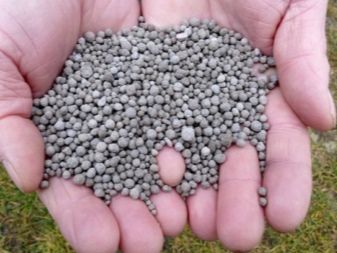
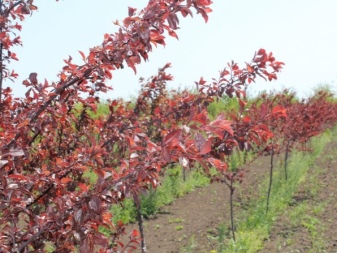
Pruning
It is required for shrub forms and ornamental trees. Trimming the crown helps thin it out, eliminating stagnant moisture and air. In a properly formed tree or bush, insects appear less often, the plant remains healthy. Ornamental drains are pruned annually. Most often, the crown is formed sparsely, as well as vase-like or in the form of a ball, in pyramidal variants it is preserved.
Sanitary pruning is also mandatory in the spring or fall. Its main purpose is to remove overgrown, broken, damaged and diseased shoots. It is necessary to cut these sections of the crown with a sharp garden pruner. On large branches, wounds must be treated with a disinfectant solution and garden varnish.
It is very important to remove root growth from red-leaved plums. If this is not done, the trunk will develop incorrectly, the plants will begin to lose the moisture and nutrients they need.

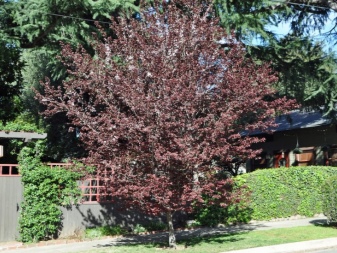
The cut root shoots can be used for further propagation using the clonal rootstocks method.













The comment was sent successfully.